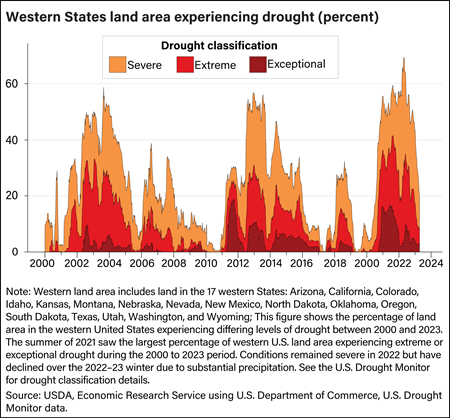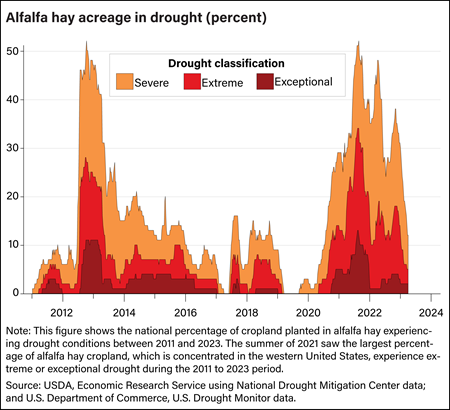
Drought in the Western United States
The U.S. Drought Monitor (USDM) categorizes drought—with a scale from D0 (Abnormally Dry) to D4 (Exceptional Drought)—according to soil moisture, streamflow, and precipitation levels. Regional designations can vary and are primarily based on historical weather patterns.
Drought can adversely affect many aspects of the U.S. agricultural sector. In regions that rely on rainfall for agricultural production, drought can diminish crop and livestock outputs and may severely affect farm profitability. Drought also reduces the quantity of snowpack and streamflow available for diversions to irrigated agricultural land. These impacts can reverberate throughout the local, regional, and national economies. Locally, droughts can reduce farm income and negatively impact food processing and agricultural service sectors, while food prices may increase at the regional and the national levels.
As of April 4, 2023, drought conditions have improved across much of the western United States compared to 2021 and 2022. (The 17 western States are Arizona, California, Colorado, Idaho, Kansas, Montana, Nebraska, Nevada, New Mexico, North Dakota, Oklahoma, Oregon, South Dakota, Texas, Utah, Washington, and Wyoming.) Conditions were most severe in Nebraska, Kansas, Oklahoma, Texas, New Mexico, and Oregon. According to USDM, on April 04, 2023, 12 percent of land in western states was classified as experiencing extreme or exceptional drought, with an additional 20 percent classified as severe. Data reported by USDM demonstrate the incidence of drought in the western United States during the summer of 2021 exceeded all past droughts in the region since 2000. Drought conditions in the western United States gradually subsided between October and December of 2021 and began intensifying again during the first half of 2022. Significant precipitation over the 2022–23 winter has reduced the prevalence of drought in many western states.
Drought conditions in the western United States have important implications for the agricultural sector. According to the National Drought Mitigation Center (NDMC), as of April 4, 2023, approximately 12 percent of alfalfa hay acreage in the United States was experiencing severe, extreme, or exceptional drought conditions. This number is a decline from the peak of drought conditions in August of 2021 when 52 percent of alfalfa hay acreage was affected by severe or worse drought conditions. The historically severe drought conditions in the western United States during the summer of 2021 were significant for the broader agricultural sector. For example, alfalfa hay is an important input for livestock and dairy operations and much of its production affecting alfalfa hay acreage have the potential to reduce yields, which may influence feed and consumer prices.
Please visit the National Integrated Drought Information System's Agriculture Sector webpage for a map of the latest U.S. areas experiencing drought and the agricultural activity in those areas.
USDA, Economic Research Service (ERS) Drought-Related Resources
- Commodity Outlook Reports contain information on the impacts of recent drought on various commodities.
- Wheat Outlook: April 2023 (Drought discussion: pages 4 and 8)
- Livestock, Dairy, and Poultry Outlook: March 2023 (Drought discussion: page 26)
- Wheat Outlook: March 2023 (Drought discussion: page 3)
- Livestock, Dairy, and Poultry Outlook: February 2023 (Drought discussion: page 3)
- Wheat Outlook: February 2023 (Drought discussion: page 3)
- Past Outlook Reports:
- Livestock, Dairy, and Poultry Outlook: January 2023 (Drought discussion: page 3)
- Rice Outlook: January 2022 (Drought discussion: page 6)
- Wheat Outlook: January 2022 (Drought discussion: page 4)
- Livestock, Dairy, and Poultry Outlook : December 2022 (Drought discussion: page 3)
- Wheat Outlook: December 2022 (Drought discussion: paged 3 and 12)
- Livestock, Dairy, and Poultry Outlook: November 2022 (Drought discussion: page 3)
- Wheat Outlook: November 2022 (Drought discussion: page 4)
- Feed Outlook: November 2022
- Wheat Outlook: October 2022 (Drought discussion: pages 5 and 6)
- Feed Outlook: October 2022 (Drought discussion: pages 1,2,8 and 10)
- Livestock, Dairy, and Poultry Outlook: August 2021 (Drought discussion: pages 3 and 9)
- Vegetable and Pulses Outlook: April 2021 (Drought discussion: pages 10,12, 33, 38, and 43)
- Rice Outlook: April 2018 (Drought discussion: pages 11–14)
- State Fact Sheets include data by State relating to top agricultural commodities, exports, and counties.
- The Food Price Outlook provides monthly forecasts for retail food price inflation.
Publications
- Irrigation Organizations: Groundwater Management
- Irrigation Organizations: Drought Planning and Response
- Trends in U.S. Irrigated Agriculture: Increasing Resilience Under Water Supply Scarcity
- Irrigation Organizations: Water Storage and Delivery Infrastructure
- Tracking the U.S. Domestic Food Supply Chain’s Freshwater Use Over Time
- Development, Adoption, and Management of Drought-Tolerant Corn in the United States
Amber Waves
- "Groundwater Organizations Promote Aquifer Stewardship for U.S. Agriculture"
- "Some Irrigation Organizations Rely on Formal Drought Plans"
- "Trends in Irrigated Agriculture Reveal Sector’s Ability To Adapt to Evolving Climatic, Resource, and Market Conditions"
- "Irrigation Organizations Use Conveyance Infrastructure To Deliver Water to Irrigated Farms and Ranches"
- "U.S. Food-Related Water Use Varies by Food Category, Supply Chain Stage, and Dietary Pattern"
- "Drought-Tolerant Corn in the United States: Research, Commercialization, and Related Crop Production Practices"
- "Farmers Employ Strategies to Reduce Risk of Drought Damage"
Topic Pages
Charts of Note
- Groundwater organizations see nitrate contamination as top concern
- Degraded water quality, declining well capacity affect many groundwater organizations
- Drought conditions in Western States in summers of 2021, 2022 were the most intense in 20 years
- Beef cattle producers face higher input costs, with feed prices up 16 percent since 2021
- Most formal drought plans for irrigation organizations specify rules for drought-induced water restrictions
- Large organizations deliver 80 percent of off-farm irrigation water
- Drought dampens production and export prospects for key U.S. wheat classes
- Drought-tolerant corn varieties often planted on non-irrigated fields



